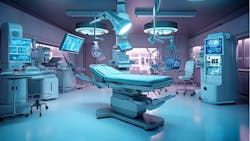Horizon-scanning next-generation surgical beds, tables, exam chairs
Whether you’re an inpatient or outpatient at a hospital or ambulatory surgery center, meeting with your doctor or surgeon at a clinic or physician’s office, chances are high that you as a patient have draped your body onto a surgical bed or table or folded your frame into an exam or procedure/treatment chair.
Although classified as medical/surgical equipment, these beds, tables and chairs represent a trio of patient-centric workhorses seeing as how the patient likely spends the most of his or her time on any of them during an appointment or stay of any length.
Yet over the decades this trio has undergone a wealth of updates and upgrades – both technological and mechanical – so that to borrow and adapt a refrain from an old car commercial, they are not your father’s surgical beds and tables and exam and procedure/treatment chairs anymore.
As a result, Healthcare Purchasing News (HPN) tapped the foresight of executives within several of the leading manufacturers of this medical/surgical equipment as a creative glimpse ahead of “what could-what might-what should” be in a future view of this foundational equipment in inpatient and outpatient settings.
Disclaimer: HPN explicitly advised sources not to share any trade secrets, upcoming design revelations or product manufacturing plans in their responses. HPN just asked them to “imagine what if” to tickle the possibilities. As a result, none of what is shared represents any indication or intent of product design/manufacturing direction. The goal was to motivate ideation and open-mindedness that is entertaining, informative and maybe just a little bit profound.
What providers need
Surgical beds and tables and exam and procedure/treatment chairs may seem like bread-and-butter, meat-and-potatoes medical/surgical equipment, but that doesn’t necessarily mean providers cannot get creative and flexible in making effective and efficient use of them for workflow and patient benefits.
August Boehnlein, associate marketing manager, Midmark, chuckles at the thought and waxes philosophical.
“With so much focus on wants and needs for the future of healthcare, this made me think of an anonymous inspirational quote, ‘Focus on what you want, but never forget to be grateful for what you already have,’” he indicated. “How can we as healthcare manufacturers, providers and even patients utilize what we already have, to create a better healthcare environment in the future?”
Then Boehnlein migrates to the metaphysical to put things in perspective.
“At Midmark, we do not just manufacture exam and procedure chairs, we design fully integrated healthcare ecosystems that help improve the clinician’s ability to work in a more effective and efficient workflow that not only save the provider time but can also improve the overall experience and outcomes for the patient,” he noted. “When designing an exam room that promotes a more effective and efficient workflow, we focus on the needs of both the patient and the provider. Both need an exam chair that is not just comfortable but is also easy for the patient to transfer on and off, and easy for the provider to position the patient, especially when a patient has a mobility challenge.”
Boehnlein refers to the “Next-Generation Surgical Beds & Tables, Exam & Procedure/Treatment Chairs Grid” as showcasing useful capabilities and features that share a common goal – to create a more effective and efficient workflow by decreasing the workload on the clinical staff.
“One way to accomplish this goal is to have an exam chair that allows the patient to transfer on and off without help,” he explained. “This allows the patient to feel more independent while also reducing the burden on the staff. Having an exam chair with a powered base and backrest that allows the provider to easily position the patient further reduces the strain on the clinical staff, which can improve the exam room workflow.
“However, patient transfer and positioning are only the beginning of the patients’ experience – what about during the actual exam or procedure?” Boehnlein continued. “When designing a healthcare ecosystem that promotes an efficient and effective workflow, we want to help ensure that providers have everything they need, not just in the exam room, but at the point of care.
“For example, providers can utilize a mobile treatment cabinet to position their supplies to be within arm’s reach throughout the duration of the exam or procedure,” he noted. “This way, providers can focus on the patient’s needs during the entirety of the exam instead of spending valuable time away from the patient, grabbing supplies in another room. Should providers need an additional work surface for the exam or procedure, a mobile treatment cabinet can be used, or providers can utilize a mobile workstation to place their laptop or other device on, right next to them and the patient. Instead of providers having to constantly leave the patient’s side or the room to get everything they need during the exam, what if we design everything they need to be easily positioned at the point of care?”
For Boehnlein, this encompasses the exam chair, mobile treatment cabinets, workstations, lighting and vital signs devices, which represents everything Midmark manufactures for the clinical setting.
Julie Brewer, president, Patient Support Systems, Global Surgical Solutions and Care Communications, Baxter International, which owns the Hillrom brand of equipment and products, emphasizes convenience.
“Care teams are overwhelmed and overloaded and don’t need more steps added to their workflows and procedures,” Brewer said. “The best way to get more value out of an existing bed and surgical table fleet is to focus on the features that either remove manual work, like documentation, or can remove steps from the normal workflow in that care area.” With her extensive background in care and connectivity solutions and patient support systems, she has her palm on the pulse of operational demands.
“For example, we sometimes see beds that have the ability to connect to their nurse call system, but the hospital hasn’t activated the connection,” she noted. “While it takes some effort to integrate beds and nurse call systems, it can help streamline the information flow to the care team, especially by providing alerts and information outside the room, whether delivered on a dome light or to a mobile device.
“Another potential area for efficiency is to enable remote asset tracking and remote service capabilities,” Brewer continued. “Knowing where every bed in the hospital is currently, seeing use status and accessing potential service issues from a central app can save valuable staff time and make sure the fleet is being used as efficiently as possible.”
What providers want
Suppliers prefer to be plugged into the needs and wants of their provider customers, particularly involving high-cost medical/surgical equipment. The astute recognize and understand that forward-thinking providers seek convenience, convergence, compatibility and portability, among leading concerns.
“First and foremost, our customers are looking for more integration of the devices and systems within the care area,” Baxter’s Brewer assured. “We see this as the first step in bringing together data from different sources so that it can be made actionable for the care team, both for real-time decisions and to identify trends that can impact efficiency and quality performance. Right now, most equipment and devices are disconnected, leaving untapped potential for connectivity solutions that bring that information together seamlessly.
“In the operating room, we believe that OR integration is the future and that goes beyond the surgical table,” she insisted. “OR integration can help with faster room setup and turnover, provide access to valuable patient information during the procedure and connect members of the care team who are outside of the OR.”
For Midmark’s Boehnlein, the key terms center on workload and workflow.
“Like the impressive future capabilities and features listed [in the grid], the key capabilities and elements that we have heard end users say they need or would like to have on their exam or procedure chairs all center around reducing the workload on the clinical team to promote a more effective and efficient workflow that improves the experience and outcomes for the patient,” he noted.
Boehnlein recognizes that whether ambulatory or acute care, the future needs and wants of healthcare systems intersect and many may already be available to them.
“With the recent pandemic, one of the biggest needs end users continue to focus on is infection prevention,” he indicated. “Having removable and seamless upholstery that is easily cleaned and disinfected not only saves the clinical team time but also prevents the transmission of harmful contagions. Similarly, having an exam or procedure chair that is mobile allows the clinical team to clean the floor underneath the chair to keep the exam room clean more effectively and efficiently for each and every patient visit.
“Often, the needs and wants of providers are really focused on the needs of the patients,” Boehnlein continued. “For example, many end users want a fully ADA-compliant height adjustable exam chair that allows the patient to independently transfer on and off the exam chair and allows the provider to easily position the patient. Having an exam chair with these two qualities can help improve the exam room workflow and the patient care experience.”
Still, Boehnlein notes that patients offer helpful perspectives, too.
“Sometimes end users want something as simple as a comfortable exam or procedure chair that provides a stress-free calming environment for the patient. A patient feeling stressed or anxious can inhibit an efficient workflow and negatively impact the patient’s overall care experience,” he noted.
Flexibility and versality remain important, too, according to Boehnlein.
“Often, end users want an exam or procedure chair that is versatile enough to allow clinicians to use the same chair for different clinical functions,” he said. “For example, simple features like standard built-in paper roll holders, debris trays, and even stirrups are often requested by the end user to increase the capabilities and functionality of the chair. Having exam or procedure chairs that are compatible with common accessories like knee crutches for OB/GYN exams and procedures or articulating arm boards for hand procedures, further increases the functionality and the versatility of the chair for the end user.
“A versatile exam or procedure chair that can be used for many different clinical functions reduces the care space required by the end user, which helps to promote an efficient workflow by reducing the workload on the clinical team while also improving the overall experience and outcomes for the patient,” he added.
Spanning the spectrum of potential technological development
Next-generation surgical beds, tables and exam, procedure/treatment chairs inspire promise
How do surgical equipment experts categorize next-generation beds, surgical tables and exam and procedure/treatment chairs along a spectrum that spans complete luxury, luxury-leaning, even, necessity-leaning and complete necessity? Check out Healthcare Purchasing News’ Next-Generation Beds, Surgical Tables and Exam Chairs Grid to learn where they generally assigned options from a list of 17 potential choices with the option of suggesting their own.
Disclaimer: HPN explicitly advised sources not to share any trade secrets, upcoming design revelations or product manufacturing plans in their responses. HPN just asked them to “imagine what if” to tickle the possibilities. As a result, none of what is shared represents any indication or intent of product design/manufacturing direction. The goal was to motivate ideation and open-mindedness that is entertaining, informative and maybe just a little bit profound.
NEXT-GENERATION SURGICAL BEDS & TABLES, EXAM & PROCEDURE/TREATMENT CHAIRS GRID
COMPLETE LUXURY
- Per Scandinavian design, beds, chairs, tables (when not occupied) equipped with movable shelving underneath that can be folded upright into a wall as intact usable shelving folds down.
- Articulating robotic arm attached to handrails to retrieve products/supplies nearby.
- Augmented/virtual reality (AR/VR) headgear for communication, education, entertainment, information, instructions, etc., attached to handrails.
- Multi-sensor mobile overlay that arcs over the bed, table or chair and can be moved along the handrails, enabling/facilitating body scanning.
LUXURY LEANING
- Automated drive capabilities for easier movement within rooms, along hallways, etc. (e.g., remote-control activated or ceiling/doorway/floor-mounted sensors, etc.) akin to automated guided vehicles (AGVs).
- Equipping handrails with flatscreens either directly or via articulating arm that enable caregiver and patient to access multimedia and electronic records safely and securely.
EVEN
- Pinoles in mattress that enable air to circulate to prevent pressure sores.
- Frame coated/constructed with antimicrobial materials for easier and more thorough cleaning and decontamination.
- Handles, rails equipped with mobile ultrasound and X-ray imaging devices.
- Capability of folding bed, table or chair (when unoccupied and without mattress or cushions) into smaller, more compact packages for easy transport and UV disinfection/sterilization.
NECESSITY LEANING
- Mattress consisting of/filled with air, foam, gel or water that can be adjusted for firmness or softness, cooling or heating.
COMPLETE NECESSITY
- Fiberoptic threads or sensors in mattress that track body positioning and send alerts for movement reminders. “Microclimate management in air mattress to remove excess heat and moisture from the skin to help prevent pressure sores,” suggested Julie Brewer, president, Baxter International.
- Wireless tracking of selected vital signs (e.g., weight from frame “scale,” blood pressure from wrist-worn sensors, etc.). “We already offer this feature on our Centrella med-surg bed,” Brewer noted. “More information here: Continuous Patient Monitoring Device with EarlySense | Hillrom.”
- Handheld automated positioning that facilitates sitting postures and assistance to get up and out for restroom breaks, walking and wheelchair access.
- Adding articulation points to Trendelenburg positioning to accommodate easier access to all four limbs.
- Product/supply cubbies attached to handrails that may house such items as tissues, etc. so patient doesn’t have to reach for the adjacent cabinet/end table, overbed table or call a nurse for assistance.
- Small beverage cask attached to the bed, chair or table that enables patient to drink via sterile rubber hose (and not have to reach for the cup on the adjacent cabinet/end table or overbed table or call a nurse for assistance). Think of the racecar driver drinking through a hose attached to the helmet to cool off during active competition or in pit lane.
OTHER LUXURY
- “An inpatient bed that can massage patients for increased comfort,” said August Boehnlein, associate marketing manager, Midmark.
OTHER NECESSITY
- Attached multimedia screens that allow EMR connectivity but also allow patients to virtually connect to, and communicate with, family/visitors during and/or after exam,” Boehnlein continued.
- “A fully functional and reliable AI system (like Amazon’s Alexa) on exam chair that automatically inputs information, in real time, from the exam into the patient’s EMR, saving the provider time by preventing them from having to manually input patient information. This AI system can also use the information to recommend prescriptions/treatments for the provider to prescribe to the patient,” Boehnlein added.
- “Automatic measurement of the height and calculation of tidal volume (using the weight and the height measured by the bed),” Brewer indicated.
- “Automatic calculation of ICU parameters using the surface as invasive pressures (arterial pressure) SPO2 with the surface,” she continued.
- “Closed loops of response with other devices (e.g., the ICU bed goes to CPR position if the monitor detects an atrial fibrillation (AF)),” she recommended.
About the Author
Rick Dana Barlow
Senior Editor
Rick Dana Barlow is Senior Editor for Healthcare Purchasing News, an Endeavor Business Media publication. He can be reached at [email protected].




